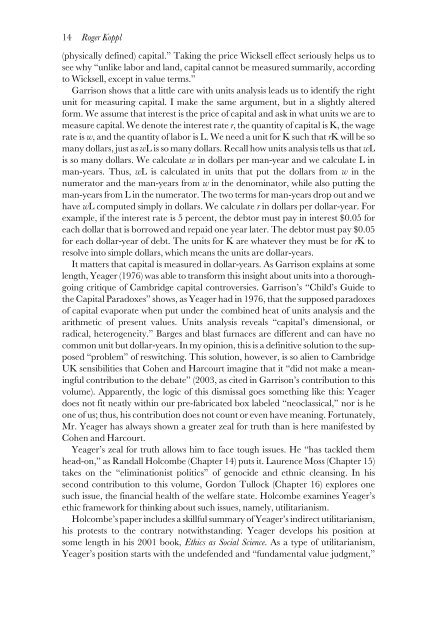Money and Markets: Essays in Honor of Leland B. Yeager
Money and Markets: Essays in Honor of Leland B. Yeager
Money and Markets: Essays in Honor of Leland B. Yeager
You also want an ePaper? Increase the reach of your titles
YUMPU automatically turns print PDFs into web optimized ePapers that Google loves.
14 Roger Koppl(physically def<strong>in</strong>ed) capital.” Tak<strong>in</strong>g the price Wicksell effect seriously helps us tosee why “unlike labor <strong>and</strong> l<strong>and</strong>, capital cannot be measured summarily, accord<strong>in</strong>gto Wicksell, except <strong>in</strong> value terms.”Garrison shows that a little care with units analysis leads us to identify the rightunit for measur<strong>in</strong>g capital. I make the same argument, but <strong>in</strong> a slightly alteredform. We assume that <strong>in</strong>terest is the price <strong>of</strong> capital <strong>and</strong> ask <strong>in</strong> what units we are tomeasure capital. We denote the <strong>in</strong>terest rate r, the quantity <strong>of</strong> capital is K, the wagerate is w, <strong>and</strong> the quantity <strong>of</strong> labor is L. We need a unit for K such that rK will be somany dollars, just as wL is so many dollars. Recall how units analysis tells us that wLis so many dollars. We calculate w <strong>in</strong> dollars per man-year <strong>and</strong> we calculate L <strong>in</strong>man-years. Thus, wL is calculated <strong>in</strong> units that put the dollars from w <strong>in</strong> thenumerator <strong>and</strong> the man-years from w <strong>in</strong> the denom<strong>in</strong>ator, while also putt<strong>in</strong>g theman-years from L <strong>in</strong> the numerator. The two terms for man-years drop out <strong>and</strong> wehave wL computed simply <strong>in</strong> dollars. We calculate r <strong>in</strong> dollars per dollar-year. Forexample, if the <strong>in</strong>terest rate is 5 percent, the debtor must pay <strong>in</strong> <strong>in</strong>terest $0.05 foreach dollar that is borrowed <strong>and</strong> repaid one year later. The debtor must pay $0.05for each dollar-year <strong>of</strong> debt. The units for K are whatever they must be for rK toresolve <strong>in</strong>to simple dollars, which means the units are dollar-years.It matters that capital is measured <strong>in</strong> dollar-years. As Garrison expla<strong>in</strong>s at somelength, <strong>Yeager</strong> (1976) was able to transform this <strong>in</strong>sight about units <strong>in</strong>to a thoroughgo<strong>in</strong>gcritique <strong>of</strong> Cambridge capital controversies. Garrison’s “Child’s Guide tothe Capital Paradoxes” shows, as <strong>Yeager</strong> had <strong>in</strong> 1976, that the supposed paradoxes<strong>of</strong> capital evaporate when put under the comb<strong>in</strong>ed heat <strong>of</strong> units analysis <strong>and</strong> thearithmetic <strong>of</strong> present values. Units analysis reveals “capital’s dimensional, orradical, heterogeneity.” Barges <strong>and</strong> blast furnaces are different <strong>and</strong> can have nocommon unit but dollar-years. In my op<strong>in</strong>ion, this is a def<strong>in</strong>itive solution to the supposed“problem” <strong>of</strong> reswitch<strong>in</strong>g. This solution, however, is so alien to CambridgeUK sensibilities that Cohen <strong>and</strong> Harcourt imag<strong>in</strong>e that it “did not make a mean<strong>in</strong>gfulcontribution to the debate” (2003, as cited <strong>in</strong> Garrison’s contribution to thisvolume). Apparently, the logic <strong>of</strong> this dismissal goes someth<strong>in</strong>g like this: <strong>Yeager</strong>does not fit neatly with<strong>in</strong> our pre-fabricated box labeled “neoclassical,” nor is heone <strong>of</strong> us; thus, his contribution does not count or even have mean<strong>in</strong>g. Fortunately,Mr. <strong>Yeager</strong> has always shown a greater zeal for truth than is here manifested byCohen <strong>and</strong> Harcourt.<strong>Yeager</strong>’s zeal for truth allows him to face tough issues. He “has tackled themhead-on,” as R<strong>and</strong>all Holcombe (Chapter 14) puts it. Laurence Moss (Chapter 15)takes on the “elim<strong>in</strong>ationist politics” <strong>of</strong> genocide <strong>and</strong> ethnic cleans<strong>in</strong>g. In hissecond contribution to this volume, Gordon Tullock (Chapter 16) explores onesuch issue, the f<strong>in</strong>ancial health <strong>of</strong> the welfare state. Holcombe exam<strong>in</strong>es <strong>Yeager</strong>’sethic framework for th<strong>in</strong>k<strong>in</strong>g about such issues, namely, utilitarianism.Holcombe’s paper <strong>in</strong>cludes a skillful summary <strong>of</strong> <strong>Yeager</strong>’s <strong>in</strong>direct utilitarianism,his protests to the contrary notwithst<strong>and</strong><strong>in</strong>g. <strong>Yeager</strong> develops his position atsome length <strong>in</strong> his 2001 book, Ethics as Social Science. As a type <strong>of</strong> utilitarianism,<strong>Yeager</strong>’s position starts with the undefended <strong>and</strong> “fundamental value judgment,”
















